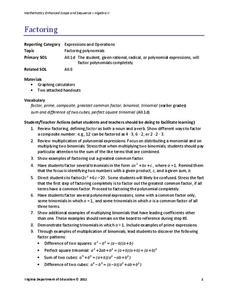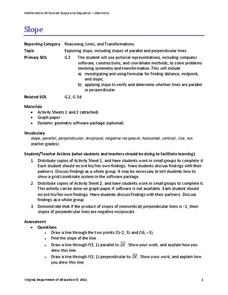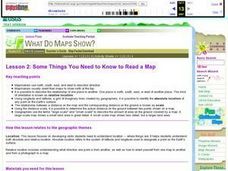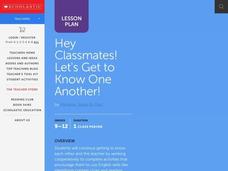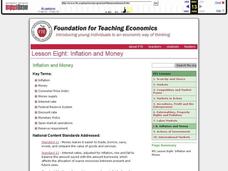Virginia Department of Education
Factoring
Uncover the relationship between factoring quadratics and higher degree polynomials. Learners develop their factoring skills through repetition. A comprehensive instructional activity begins with quadratics and shows how to use the same...
02 x 02 Worksheets
Slope
What does slope have to do with lines? Pupils work with lines and determine the slope of the lines informally and with the slope formula. Groups use their knowledge to calculate the slopes of parallel and perpendicular lines. They also...
NOAA
What's a CTD?
Why are the properties of the water important when exploring the ocean? Young scientists discover the tools and technology used in deep sea exploration in the fourth installment in a five-part series. Groups work together to examine...
Curated OER
Roller Coasters
Twisting and turning through the sky, roller coasters are popular attractions at amusement parks around the world, but how exactly do they work? Explore the physics behind these thrilling rides with an engineering design activity....
Readington Township Public Schools
Facts Practice Using Multiplication/Division Fact Triangles
Why waste time teaching multiplication and division facts separately, when this resource allows you to cover both concepts at once. Displaying the fact families for all single-digit factors, these triangle shaped flash cards are a great...
Fluence Learning
Writing About Literature: What Is Happiness?
Jack London's heart for adventure has come to define the spirit of America and its frontier. Selected passages from the foreword The Cruise of the Snark take eighth graders through London's construction and voyage of his ship before...
Curated OER
Acid-Base Indicators
The first two pages provide a chart to complete with results of a lab test using different solutions and indicators. The data analysis questions will help your students understand the concentrations of the solutions and how they affect...
Curated OER
Diurnal Temperature Changes and Water Vapor Content
High schoolers examine the greenhouse effect, as they determine how moisture in the air affects the diurnal temperature range. Their investigation help them to explain different climatological regimes of both the Southern Great Plains...
Curated OER
Chance Art: Pollock, Cage and Cunningham
Students clearly identify commonalities and differences between dance and other disciplines with regard to fundamental concepts such as materials, elements, and ways of communicating meaning.
Curated OER
Some Things You Need to Know to Read a Map
Young scholars study things the you need to know to read a map and explain location.
Curated OER
The Oneida Community and Birth Control
Learners examine the practice of mail continence in Oneida. They explore the reasons behind the community's practice of limiting births. They discuss the relationship between reproductive freedom and woman's rights.
Curated OER
Poetry in Song
Have your music lovers examine song lyrics and identify the poetry elements or tools used by a lyricist. They review the song individually before working in groups to discuss what they discovered about the song's narrator or character...
Curated OER
Sexual Development
Pupils identify what puberty is and what changes they can expect during this period of time. Students discuss the challenging aspects of puberty and celebrate the best and most exciting aspects. Pupils record the best/easiest things...
Curated OER
Geography and Culture
Students explore African geography, study the overall continent of Africa and its individual countries, discuss demographics, and participate in research and class activities.
Curated OER
Hey Classmates! Let's Get to Know One Another!
Two word puzzles encourage collaboration among learners. One sheet has numbers and initials that show a relationship and the other has pictorial images that represent a phrase. Partners cooperate in order to develop functional working...
Curated OER
Mayan Math
Fifth graders investigate the Maya's as mathematicians. In this Mayan math lessons, 5th graders work with the ancient Mayan numbering system by comparing it to the American Number System. They tell the differences and similarities...
Curated OER
Prairie Scavenger Hunt
Here is a simple lesson for young learners on the plants, animals, and flowers found in the prairie environment. There are worksheets embedded in the plan that pupils use once a teacher-led discussion and demonstration has taken place....
Curated OER
Inflation and Money
High schoolers examine the relationship between inflation and money. Defining key terms, they define money in terms of its functions and give examples of money. They discover what happens when inflation occurs unexpectedly. They also...
Curated OER
Food Chain
Third graders role-play various organisms from a food chain to illustrate how a food chain works. In relay style, 3rd graders fill their cups (stomachs) and, in turn, fill a larger organism's cup (stomach) to visualize the importance of...
Curated OER
Map Scale
Young scholars investigate the purpose of map scale and how it is used to measure the distance and the size of objects.
Curated OER
The Figure of Paul Revere. Romanticizing Colonial American History
Pupils compare paintings to make conclusions about American History in the Revolutionary War time period. Students share opinions concerning visual art. Other artwork can be used to entice inquiry as needed.
Curated OER
Pumpkin Problems
Students participate in a lesson that has the intention of working on estimation skills. They use pumpkins to estimate the number of seeds are inside. They collect data for each pumpkin and compare it to the estimation. Students question...
Curated OER
Maps and Modes, Finding a Mean Home on the Range
Fifth graders investigate data from maps to solve problems. In this data lesson, 5th graders study maps and collect data from each map. Students present their data in a variety of ways and calculate the mode, mean, median, and range.
Curated OER
Flying with Pythagoras
A lengthy narrative about Pythagoras and his students precedes an activity in which your young mathematicians practice using the Pythagorean theorem to solve three problems about flight and distance. Answers are provided.


